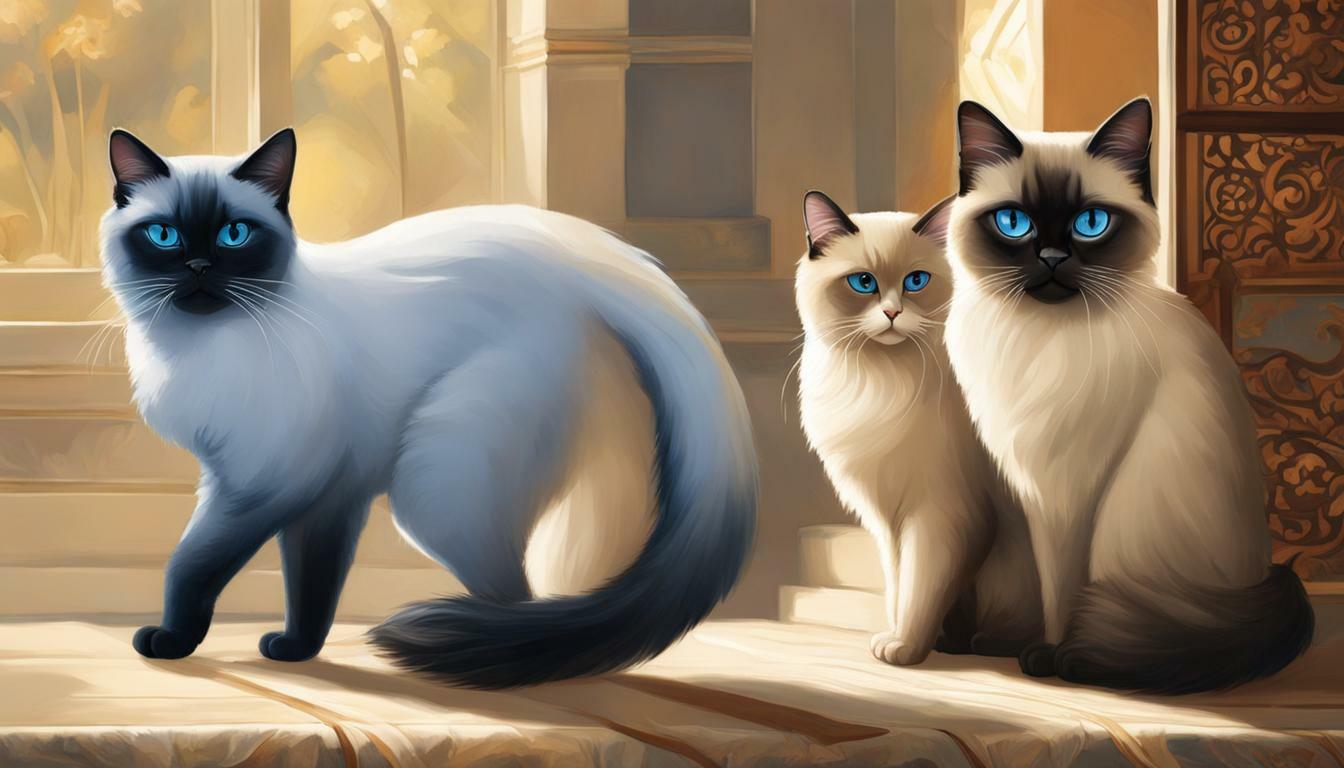For cat lovers, choosing between different breeds can be overwhelming. Among the most popular breeds are the American Shorthair and the British Shorthair cats. While both breeds have many similarities, they also have distinct differences that set them apart.
Key Takeaways:
- American Shorthair and British Shorthair cats are popular breeds with similarities and differences.
- Exploring the lineage, physical characteristics, temperament, and care needs of each breed can help cat owners make an informed decision.
- Both breeds make great pets, but understanding their differences is essential to provide the right care and environment for each cat.
Breed Origins and Lineage
The American Shorthair and British Shorthair cats are two of the most popular and beloved breeds in the world. Both breeds have fascinating stories of how they came to be, with unique lineages that make them stand out amongst other felines.
The American Shorthair’s lineage can be traced back to the early days of American colonies, where they were used to control the rodent population on ships as well as in homes and businesses. These cats were highly valued for their hunting skills and became prevalent in American households in the 19th century. It wasn’t until 1906 that they were officially recognized as a breed by the Cat Fanciers’ Association (CFA).
On the other hand, the British Shorthair has a much longer history, dating back to ancient Rome where they were brought over by Roman invaders. They were originally used to hunt rodents in the streets and were eventually bred with other felines, leading to their distinct appearance and temperament. In the 19th century, the British Shorthair was further refined through selective breeding, which helped establish the breed’s unique characteristics. The CFA recognized the British Shorthair in 1901.
Breed Origins and Lineage
Both breeds have their own unique lineage, which has led to their distinct characteristics and traits. The American Shorthair has a long history in America and was highly valued for their hunting skills, while the British Shorthair has a much longer history, dating back to ancient Rome.
| Breed | Lineage | Year recognized by CFA |
|---|---|---|
| American Shorthair | American colonies | 1906 |
| British Shorthair | Ancient Rome | 1901 |
Understanding the origins of these breeds allows us to appreciate their unique qualities and the historical significance they hold as beloved members of the feline community.
Physical Characteristics and Appearance
American Shorthair and British Shorthair cats share some similarities in appearance, but they also have a few distinct differences in physical characteristics that set them apart.
| American Shorthair | British Shorthair | |
|---|---|---|
| Size | Medium to large | Medium to large |
| Body Type | Stocky and muscular | Round and plush |
| Head Shape | Slightly triangular | Rounded with chubby cheeks |
| Ears | Slightly pointed and wide set | Small and rounded |
| Eyes | Large and wide set | Round and expressive |
| Fur | Short and thick | Short and plush |
| Color | Varies widely | Typically blue, black, or silver |
As you can see, American Shorthair cats tend to be more muscular and stocky, while British Shorthair cats have a rounder, plush appearance. British Shorthairs also tend to have smaller, more rounded ears and round, expressive eyes. Additionally, British Shorthairs are often seen in blue, black, and silver fur colors, while American Shorthairs can vary in color more widely.
Overall, both breeds are known for their sturdy and healthy builds, with short, thick fur that requires minimal grooming.
Temperament and Personality Traits
American Shorthair and British Shorthair cats are known for their unique personalities and temperaments. While each breed has its own distinct characteristics, they share many similarities.
American Shorthair Temperament
American Shorthair cats are known for their friendly, outgoing personalities. They are intelligent, curious, and playful, making them a popular choice for families with children and other pets. These cats are also independent and self-sufficient, making them well-suited for busy households.
Despite their easy-going nature, American Shorthairs can be quite vocal and demanding when they want attention. They also have a strong prey drive, so it’s important to provide plenty of toys and interactive play sessions to keep them mentally stimulated and physically active.
British Shorthair Personality Traits
British Shorthairs are known for their calm, relaxed personalities. They are affectionate and loyal to their families, but can be somewhat reserved around strangers. These cats are intelligent and independent, but not as energetic or demanding as some other breeds.
British Shorthairs are also known for their love of routine and dislike of change. They thrive on a predictable schedule and can become stressed or anxious in unfamiliar environments. These cats make excellent companions for individuals or families who prefer a quieter, more laid-back lifestyle.
Overall, whether you prefer the playful and outgoing nature of the American Shorthair or the calm and steady demeanor of the British Shorthair, both breeds have unique personalities and traits that make them wonderful pets for the right home.
Care and Maintenance
American Shorthair cats and British Shorthair cats have different needs when it comes to their care and maintenance. Here are some tips to help keep your furry friend healthy and happy:
Grooming Needs
Both American Shorthair and British Shorthair cats have short fur that requires minimal grooming. However, regular brushing will help keep their coats shiny and healthy. Use a soft-bristled brush to remove loose fur and distribute natural oils evenly.
If you notice your cat is shedding excessively, consider adding a wet food diet to their routine. This can help improve the health of their coat and reduce shedding.
Diet and Nutrition
When it comes to feeding your cat, it’s important to choose high-quality food that meets their nutritional needs. American Shorthair cats are known to have a hearty appetite and can become overweight if their diet is not carefully monitored. British Shorthair cats, on the other hand, tend to be less active and may require fewer calories.
Consult with your veterinarian to determine the best feeding schedule and portion sizes for your cat based on their age, weight, and overall health.
Exercise and Playtime
Both American Shorthair and British Shorthair cats are relatively low-maintenance when it comes to exercise, but it’s still important to provide them with opportunities to play and stay active. Keep plenty of toys around the house, such as scratching posts, laser pointers, and toy mice. Encourage your cat to climb and explore their environment by setting up a cat tree or providing access to high shelves.
Regular playtime can also help reduce stress and prevent behavioral issues in both American Shorthair and British Shorthair cats.
Congratulations on Choosing the Perfect Feline Companion
By now, you have learned about the difference between American Shorthair and British Shorthair cats, their breed origins and lineage, physical characteristics and appearance, as well as their temperament and personality traits, care and maintenance. With all this information, you are now better equipped to make an informed decision about which breed is best for you.
Keep in mind that every cat is unique, even within the same breed. The personality and temperament of your cat will largely depend on their experiences, environment, and socialization. Therefore, it’s important to spend time with your cat to understand their needs and preferences.
Whether you choose an American Shorthair or British Shorthair, you can rest assured that you have made an excellent choice. These breeds are both known for their affectionate, loyal, and playful nature, making them the perfect companions for singles, families, and seniors alike.
Remember to provide your cat with the right environment, proper nutrition, and regular veterinary care to ensure they live a happy, healthy, and long life. And most importantly, shower your cat with love and attention, and they will reward you with their unconditional affection and companionship.
FAQ
Q: What is the difference between American Shorthair and British Shorthair cats?
A: American Shorthair cats and British Shorthair cats differ in their origins, physical characteristics, and temperament. While both breeds have distinct qualities, American Shorthairs tend to be more athletic and active, while British Shorthairs are known for their round faces and laid-back personalities.
Q: What is the lineage of American Shorthair and British Shorthair cats?
A: American Shorthair cats have their origins in Europe and arrived in North America with early settlers. They are descendants of working cats that helped control vermin on ships and farms. On the other hand, British Shorthair cats originated in England and have a long history dating back to Roman times.
Q: How do American Shorthair and British Shorthair cats differ in physical appearance?
A: American Shorthair cats have a muscular build, medium-sized bodies, and come in a wide variety of coat colors and patterns. British Shorthair cats, on the other hand, have a compact and sturdy build, round faces, and dense coats. They are known for their signature “teddy bear” look.
Q: What are the temperament and personality traits of American Shorthair and British Shorthair cats?
A: American Shorthair cats are known for their friendly and sociable nature. They are generally adaptable and get along well with children and other pets. British Shorthair cats are known for their independent and reserved nature. They are often described as calm and easygoing companions.
Q: What are the care and maintenance requirements for American Shorthair and British Shorthair cats?
A: American Shorthair cats have low grooming needs and require regular brushing to maintain their coat. They are generally healthy cats with few specific care requirements. British Shorthair cats have dense coats that require more frequent brushing to prevent matting. Regular vet check-ups are important for both breeds to monitor their overall health.
 Skip to main content
Skip to main content


